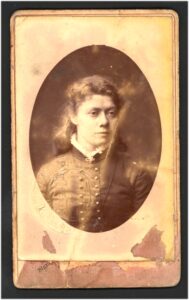 Suze Robertson (1855-1922) was a Dutch painter who depicted the peasant life and social hardships, just like Vincent van Gogh in his Brabant days. At the time she was considered as his equal. Professor August Allebé, director of the Amsterdam Academy of Visual Arts said at the end of the 19th century: ‘The paintings of Suze Robertson seem to have been painted by a woman protesting, really emotional, by bravery.’ And somewhat later Charley Toorop called her ‘the most important woman painter of the 19th century.’
Suze Robertson (1855-1922) was a Dutch painter who depicted the peasant life and social hardships, just like Vincent van Gogh in his Brabant days. At the time she was considered as his equal. Professor August Allebé, director of the Amsterdam Academy of Visual Arts said at the end of the 19th century: ‘The paintings of Suze Robertson seem to have been painted by a woman protesting, really emotional, by bravery.’ And somewhat later Charley Toorop called her ‘the most important woman painter of the 19th century.’
Photographer unknown

Suze Robertson
Mother and Child
Oil on panel
24 x 30 cm
Signed lower left
Private Collection.
Her works of simple people in farm interiors and rough scenes of farm life are reminiscent of Van Gogh’s early The Potato Eaters and it is said they admired each other’s work.
Life and work
Suze was born on 17th December 1855 in The Hague, as the youngest in a family with nine children. Her father was of Scottish descent. Her mother died when she was two and she was raised by a childless aunt and uncle, who sent her to boarding school of Elise van Calcar in Wassenaaer (near The Hague). Here she excelled in drawing and music. Doubting whether to choose a carreer in music or painting, she finally chose the latter.
She studied in The Hague, at the Academy of Visual Arts. All through her student years she fought for the rights of females to have the same quality of education as the male students, including studies of the naked body, which at the time was considered inappropriate for women. When studying in Rotterdam, this caused quite a scandal. During her last few years as an evening student in Amsterdam, she earned her living by giving drawing lessons at a girls secondary school. At the Academy in Amsterdam, she was told to focus on flower still lifes, but she rebelled and was soon allowed to work with life models.
When she finished her education she moved South to work in several villages in Noord-Brabant (Southern province in The Netherlands).
In 1892 she married Richard Bisschop, a Dutch painter of church interiors. However Suze Robertson was the breadwinner as her husband was less successful. After the birth of their daughter Sara, they settled in the Noord-Brabant village Leur (now Etten-Leur) where they raised their daughter. From 1895-1898 they lived in a house owned by Henkrik Dolk, the co-director of a sugar factory, in exchange for drawing lessons. In this period Suze painted some remarkable portraits of their nanny Petronella (‘Pietje’) Prins. Until her daughter was nine, she combined motherhood with painting. Sara was sent to boarding family and Suze Robertson took up her art with renewed energy. The years from 1900 onwards were her most productive.
Apart from Etten-Leur, she also worked in Dongen, and Gooi Region (Blaricum, Laren), Harderwijk, Katwijk and other places.
She developed a unique, quite expressive style of her own. Her palet is rather dark and she liked the earth colours. She used a broad and strong stroke of the brush as well as often dark lines. Her work – often interiors with women and children doing their daily work – projects a certain melancholy. Her paintings give evidence of hard work, poverty and hardship. Her work was often described as ‘Too manly, too chunly, not lovely or feminine enought.’ She didn’t mind her critics and was successful nevertheles. She rebelled against the prevailing standards, saying: “It’s better to be opposed than to be ignored.”
She died in The Hague on the 18th October 1922.
Professional Education
1874-1876 she studied at the Akademie van beeldende kunsten (Den Haag).
1877 Academy of Visual Arts in Rotterdam to improve her model drawing.
1880-1882 she received private lessons from Petrus van der Velden.
1882-1883 she finished her professional education at the State Academy of Visual Arts (Rijksacademie) in Amsterdam.
Exhibitions & Awards
1900 – Bronze medal at the International Exhibition in Paris.
1900 – Gold medal at the International Exhibition of Women’s labour, Londen.
1904 – Gold medal at the Exhibition in Arnhem.
1909 – Larense Kunsthandel, Laren, together with her daughter Sara, who made graphic art.
1921 – Honorary exhibition in Pulchri Studio in The Hague.
Works of Suze Robertson can be found in several Dutch museums as in private collections.
Sources
– Jacobs P., 2000, Beeldend Benelux. Tilburg, Studiecentrum voor Beeldende kunst.
– Klarenbeek, H., 2012, Penseelprinsessen & broodschilderessen, Vrouwen in de beeldende kunst 1808-1913. Bussum, uitg. Toth.
– Leeuwen, A. van, 2019, Next to Van Gogh, Suze Robertson & Marlene Welten. Catalogue of the exhibition in the Van Gogh House, Zundert.
– RKD – Netherlands Institute for Art History, The Hague.
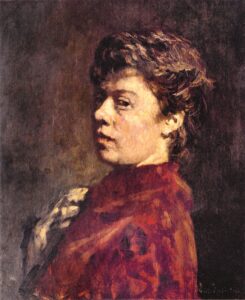
Suze Robertson
Zelfportret met Rode Jurk (Self Portrait with Red Dress), 1889-90
oil on panel
50 x 40 cm. (19.69 x 15.75 in.)
Kunstmuseum, The Hague, The Netherlands
© photographer unknown

Suze Robertson
Slapend Meisje (Girl Asleep), ca. 1889
oil on canvas
77.5 x 60 cm. (30.51 x 23.62 in.)
signed l.r.: Suze Robertson
Kunstmuseum, The Hague, NL
© photo Kunstmuseum The Hague
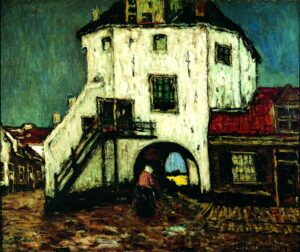
Suze Robertson
Vischpoort (Fish Gate) Harderwijk, 1908
oil on canvas
89 x 106.5 cm. (32.68 x 39.76 in.)
Singer Museum, Laren, NL
photo: courtesy Noord-Veluws Museum, Nunspeet, NL.
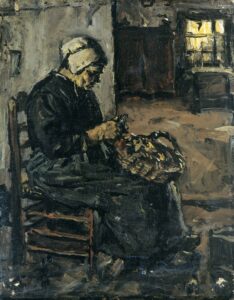
Suze Robertson
Boerenvrouw Aardappels Schillend / Peasant Woman peeling potatoes, s.d.
oil on panel
26.2 x 21 cm. (10.31 x 8.27 in.)
Rijksmuseum, Amsterdam, The Netherlands
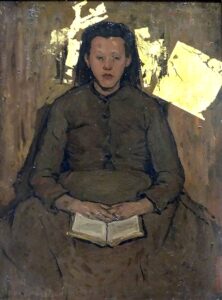
Suze Robertson
Pietje met goud / ‘Pietje’ with gold
ca. 1900
Oil painting with gold
Gouda Museum, Netherlands.
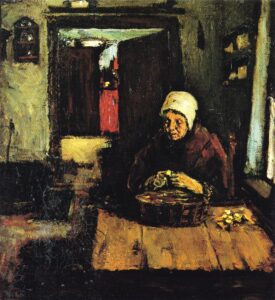
Suze Robertson
Woman peeling potatoes, s.d.
oil on canvas
56.5 x 49.5 cm. (22.24 x 19.49 in.)
private collection.